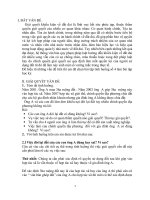CHEMISTRY 161
Bạn đang xem bản rút gọn của tài liệu. Xem và tải ngay bản đầy đủ của tài liệu tại đây (1.14 MB, 29 trang )
CHEMISTRY 161
Chapter 2
MATTER
ATOMS
John Dalton
MOLECULES
ELEMENTS
matter is composed of
‘building blocks’
Dalton’s postulates
1. Elements are composed of small particles called atoms;
atoms of an element are identical with same properties (mass)
2. Compounds are composed of atoms of more than one element;
in a compound, the ratio of the number of atoms is an integer or fraction
LAW OF DEFINITE PROPORTIONS
3. A chemical reaction involves separation and combination of atoms;
atoms are neither created nor destroyed
an atom is the basic, undividable unit of any element
1. Law of definite proportions
2. Law of conservation of mass
in a chemical reaction
no gain or loss of mass is observed
unit of mass is g (gram) or kilogram (kg)
each atom has a constant mass
atomic mass – atomic weight
Structure of an Atom
subatomic particles
electrons
protons
neutrons
proton,p 1.67262 × 10-27 kg
+1.6022 × 10-19 C +1
electron,e 9.10939 × 10-31 kg
-1.6022 × 10-19 C -1
m(p) / m(e) ≈ 1836
the atom’s positive charge is located in a small, dense central core ‘nucleus’
protons are a constituent of the nucleus
++
+ ++
1. mass of the nucleus constitutes most of the mass of the atom
2. the nucleus is positively charged and contains protons
3. the nucleus constitutes only about 1/1013 space of an atom
4. electrons are as clouds around the nucleus
Neutron
proton, p
1.67262 × 10-27 kg
+1.6022 × 10-19 C +1
electron, e 9.10939 × 10-31 kg
-1.6022 × 10-19 C -1
neutron, n 1.67493 × 10-27 kg
m(n) / m(e) ≈ 1838
m(n) > m(p)
0
0
Structure of an Atom
subatomic particles
electrons
(‘cloud’)
protons
(nucleus)
neutrons
(nucleus)
neutrons are the ‘glue’ of the nucleus
Atomic Number and Mass Number
(PSE)
mass number
(number of protons plus neutrons)
atomic number
(number of protons)
(number of electrons)
A
Z
X
in an atom, the number of electrons and protons are identical
(charge neutrality)
6 neutrons
12 protons plus neutrons
6 electrons
7 neutrons
6 protons
13 protons plus neutrons
6 electrons
6 protons
12
6
C
13
6
C
elements with same number of electrons and protons but different number of neutrons
ISOTOPES
1
1
3
1
H
2
1
H
H
16
8
1
1
O
12
6
C
H
Periodic Table of the Elements
period
g
r
o
u
p
Periodic Table of the Elements
8 main groups
10 transition metal groups
lanthanides/actinides
metals
nonmetals
metalloids (semi metals)
metals
metals
metals
– shine, conduct electricity
nonmetals – do not shine, do not conduct electricity
metalloids – properties between metals and nonmetals
HOW HEAVY ARE ATOMS?
CALCULATION
CHEMICAL MASS SCALE
standard / calibration
atomic mass unit
(amu, u)
one atom of carbon-12
12 u (exactly)
we have to correlate u with kg
MOLE
one mole of a compound contains the same
number of molecules/atoms as the number of atoms
in exactly
12 g of 12C
Avogadro’s number
Na
6.023 x 1023
1 mole of H2O
6.023 x 1023
molecules
1 mole of 12C
6.023 x 1023
atoms
1 mole of Na
6.023 x 1023
atoms
1 mole of NaCl
6.023 x 10
molecules
23
Avogadro’s number
links micro and
macroscopic world
H 2O
O:
15.999 u
H:
1.008 u
H:
1.008 u
PSE
H2O: 18.015 u
formula mass: weight of one molecule
correlation between u and kg
H 2O
O:
H:
H:
15.999 u
1.008 u
1.008 u
Na
Na
Na
15.999 g/mol
1.008 g/mol
1.008 g/mol
H2O: 18.015 u
1 mole of H2O – 18.015 g
CaO
O:
15.999 u
Ca:
40.08 u
CaO: 56.08 u
1 mole of CaO – 56.08 g
2 H2 +
O2
2 H2O
2 molecules 1 molecule 2 molecules
2 moles
1 mole
2 moles
4.03176g
31.9988g
36.03g
yg
70.0g
xg
STOICHIOMETRY
2 H2 +
O2
2 H2O
2 molecules 1 molecule 2 molecules
2 moles
1 mole
2 moles
4.03176g
31.9988g
36.03g
yg
70.0g
xg
STOICHIOMETRY









